Top Rankings
Karl G. Maeser Preparatory Academy School District ranks among the top 20% of public school district in Utah for:
Category
Attribute
Reading/Language Arts Proficiency
Highest reading/language arts proficiency (Top 5%)
For the 2025 school year, there is 1 public school serving 635 students in Karl G. Maeser Preparatory Academy School District. This district's average testing ranking is 8/10, which is in the top 30% of public schools in Utah.
Public School in Karl G. Maeser Preparatory Academy School District have an average math proficiency score of 38% (versus the Utah public school average of 39%), and reading proficiency score of 63% (versus the 43% statewide average).
Minority enrollment is 31% of the student body (majority Hispanic), which is more than the Utah public school average of 29% (majority Hispanic).
Overview
This School District
This State (UT)
# Schools
1 School
1,112 Schools
# Students
635 Students
681,035 Students
# Teachers
34 Teachers
31,284 Teachers
Student : Teacher Ratio
19:1
19:1
District Rank
Karl G. Maeser Preparatory Academy School District, which is ranked within the top 30% of all 153 school districts in Utah (based off of combined math and reading proficiency testing data) for the 2020-2021 school year.
The school district's graduation rate of 90-94% has increased from 85-89% over five school years.
Overall District Rank
#31 out of 154 school districts
(Top 30%)
(Top 30%)
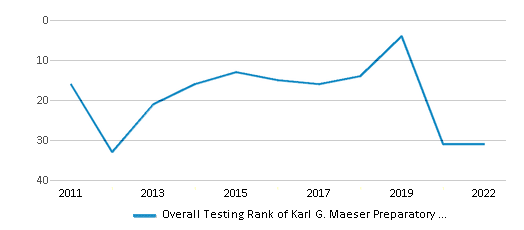
Math Test Scores (% Proficient)
(20-21)38%
39%
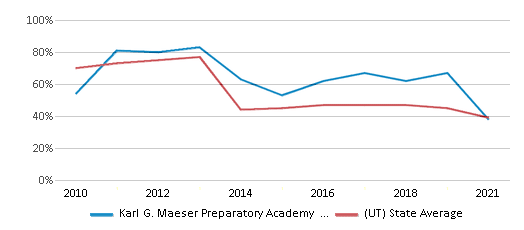
Reading/Language Arts Test Scores (% Proficient)
(20-21)63%
43%
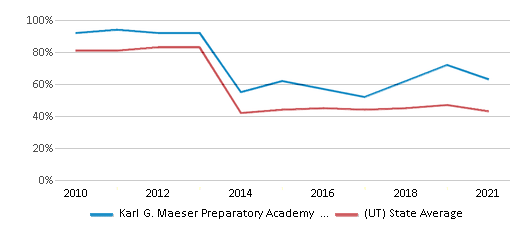
Science Test Scores (% Proficient)
(20-21)53%
45%
Graduation Rate
90-94%
88%
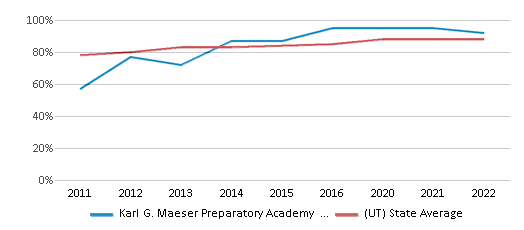
Students by Ethnicity:
Diversity Score
0.49
0.46
# American Indian Students
n/a
6,356 Students
% American Indian Students
n/a
1%
# Asian Students
56 Students
11,203 Students
% Asian Students
9%
2%
# Hispanic Students
102 Students
135,730 Students
% Hispanic Students
16%
20%
# Black Students
5 Students
8,999 Students
% Black Students
1%
1%
# White Students
441 Students
481,682 Students
% White Students
69%
71%
# Hawaiian Students
3 Students
10,774 Students
% Hawaiian Students
1%
1%
# Two or more races Students
28 Students
26,165 Students
% of Two or more races Students
4%
4%
Students by Grade:
# Students in PK Grade:
-
16,573
# Students in K Grade:
-
44,583
# Students in 1st Grade:
-
47,327
# Students in 2nd Grade:
-
50,032
# Students in 3rd Grade:
-
50,137
# Students in 4th Grade:
-
50,477
# Students in 5th Grade:
-
51,752
# Students in 6th Grade:
-
50,580
# Students in 7th Grade:
106
52,075
# Students in 8th Grade:
104
52,556
# Students in 9th Grade:
125
53,806
# Students in 10th Grade:
114
55,206
# Students in 11th Grade:
97
54,321
# Students in 12th Grade:
89
51,610
# Ungraded Students:
-
-
District Revenue and Spending
The revenue/student of $8,869 in this school district is less than the state median of $10,732. The school district revenue/student has stayed relatively flat over four school years.
The school district's spending/student of $7,405 is less than the state median of $10,829. The school district spending/student has stayed relatively flat over four school years.
Total Revenue
$6 MM
$7,309 MM
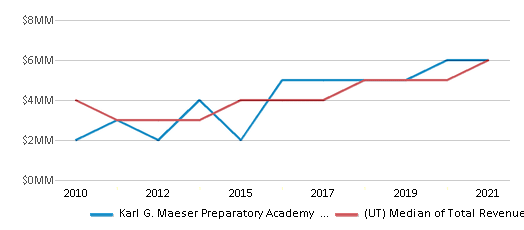
Spending
$5 MM
$7,375 MM
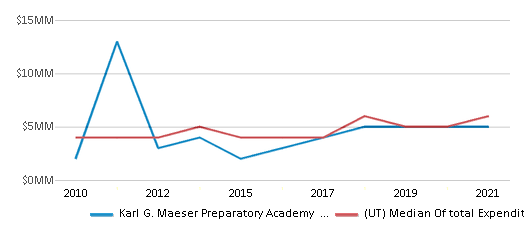
Revenue / Student
$8,869
$10,732
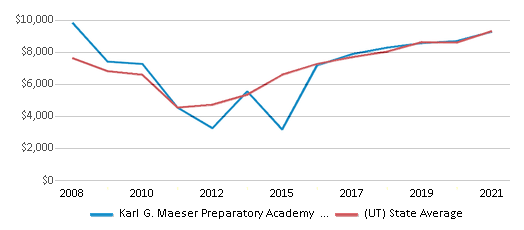
Spending / Student
$7,405
$10,829
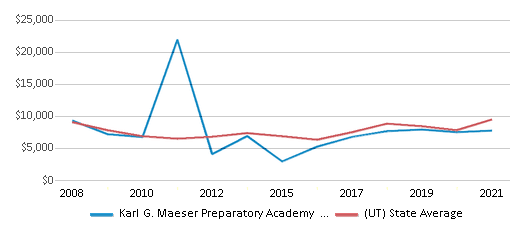
Best Karl G. Maeser Preparatory Academy School District Public Schools (2025)
School
(Math and Reading Proficiency)
(Math and Reading Proficiency)
Location
Grades
Students
Rank: #11.
Karl G. Maeser Preparatory Academy
Charter School
(Math: 38% | Reading: 63%)
Rank:
Rank:
8/
Top 30%10
320 W 600 S
Lindon, UT 84042
(801) 235-9000
Lindon, UT 84042
(801) 235-9000
Grades: 7-12
| 635 students
Frequently Asked Questions
How many schools belong to Karl G. Maeser Preparatory Academy School District?
Karl G. Maeser Preparatory Academy School District manages 1 public schools serving 635 students.
What is the rank of Karl G. Maeser Preparatory Academy School District?
Karl G. Maeser Preparatory Academy School District is ranked #32 out of 153 school districts in Utah (top 30%) based off of combined math and reading proficiency testing data for the 2020-2021 school year. This district ranks in the top 20% of Utah school districts for: Highest reading/language arts proficiency (Top 5%)
What is the racial composition of students in Karl G. Maeser Preparatory Academy School District?
69% of Karl G. Maeser Preparatory Academy School District students are White, 16% of students are Hispanic, 9% of students are Asian, 4% of students are Two or more races, 1% of students are Black, and 1% of students are Hawaiian.
What is the student/teacher ratio of Karl G. Maeser Preparatory Academy School District?
Karl G. Maeser Preparatory Academy School District has a student/teacher ratio of 19:1, which is lower than the Utah state average of 22:1.
What is Karl G. Maeser Preparatory Academy School District's spending/student ratio?
The school district's spending/student of $7,405 is less than the state median of $10,829. The school district spending/student has stayed relatively flat over four school years.
Recent Articles

Sexual Harassment at Age 6: The Tale of a First Grade Suspension
A six-year old in Aurora, Colorado, was suspended after singing an LMFAO song to a little girl in his class and reportedly “shaking his booty.” We look at the case and the sexual harassment problem in public schools today.

How Scaffolding Could Change the Way Your Child Learns
This article explores the concept of instructional scaffolding, a teaching method that enhances learning by breaking down complex tasks into manageable parts. It highlights how scaffolding supports students in developing critical thinking skills and becoming more independent learners. The article discusses the benefits of scaffolding, including improved engagement and reduced anxiety, and provides strategies for its implementation across various educational levels.

February 05, 2025
Understanding the U.S. Department of Education: Structure, Impact, and EvolutionWe explore how the Department of Education shapes American education, from its cabinet-level leadership to its impact on millions of students, written for general audiences seeking clarity on this vital institution.





